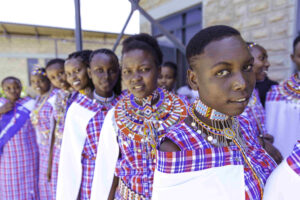
Since 2008, Amref has been working with the Masai community in Kenya and Tanzania to prevent circumcision. How are the girls who participated doing right now? Are they still going to school? Are they still uncircumcised? Do they marry and become mothers later in life? This important information from as many girls as possible is collected digitally. Making it possible to intervene when they are at risk, as well as to optimise our approach to end Female Genital Mutilation (FGM) and make it financially sustainable.
Female circumcision: a deeply rooted tradition
Worldwide, 4 million girls are at risk of circumcision every year, mainly in East Africa. In the Masai community, female circumcision is a deeply rooted tradition. Among many nomadic communities, circumcision is seen as the rite of passage from girlhood to womanhood. From circumcision, the girl is said to be ready to marry and have children. But, as Amref Flying Doctors state, circumcision marks girls for life, both physically and mentally. And on top of that, many girls are forcibly married off and become mothers at a young age. Simply legally banning this tradition is not enough; it is too deep-rooted and complex for that.
An alternative Rite de Passage to prevent circumcision
So, Amref opted for a change in the tradition. Since 2008, Amref has been working with the Masai community in Kenya and Tanzania on the Alternative Rite of Passage to prevent circumcision. For one to two years, Amref works closely with the local community on female circumcision, child marriage and the importance of education for girls. Once all community members agree that they no longer want to circumcise their girls, the ceremony follows.
That this approach has generated some excellent outcomes has already been established: research from 2020 on 10 years of ARP shows that in the areas where Amref is active, the number of circumcised girls has decreased by almost 25%. They also attend school for 2,5 years longer on average.

What happens after the ceremony?
Still, these are averages. What exactly happens to individual girls after the ceremony? Do they indeed continue to go to school? Do they marry later in life and thus also become mothers later? And: do they remain uncircumcised, or are they at risk, and are interventions necessary?
Tracking the Girls
To optimise and intervene if girls are still at risk, Amref developed and tested a promising digital application with TaroWorks and Salesforce in 2021: Tracking the Girls. This app allows continued tracking of the girls’ lives who went through the alternative ritual until they become 24.
Local healthcare providers trained by Amref enter the health data of the girls who participated in the alternative ritual. A regional healthcare provider visits and uses a questionnaire twice a year to check the girl’s or young woman’s well-being. Is she undamaged and healthy? Is she still at risk of being circumcised or married off? Is she still going to school?

Results
Over 4.200 girls have now registered on the app, and more than 200 local healthcare providers have had training in using the app. Of the girls who have gone through an alternative ritual to circumcision, 1.100 have been surveyed.
And not without effects. The answers to these questions help us in many different ways. First, the answers can show whether a girl is at risk or needs help. For example, in 2022, 139 reports were made through the app about an impending circumcision, unwanted pregnancy, sexual and gender-related violence or dropping out of school. The girls’ responses help to understand the exact situation so that the care worker can take appropriate actions. In addition, this also shows whether the program is effective or if something needs to be adjusted.
This way, Amref keeps an eye on the development of the girls and collects valuable information with which this approach to stop female circumcision can be further optimised. Finally, Amref also uses the data as evidence in discussions with policymakers and politicians.
Fortunately, most of the girls surveyed are doing well: they are healthy, going to school and able to work on their future.